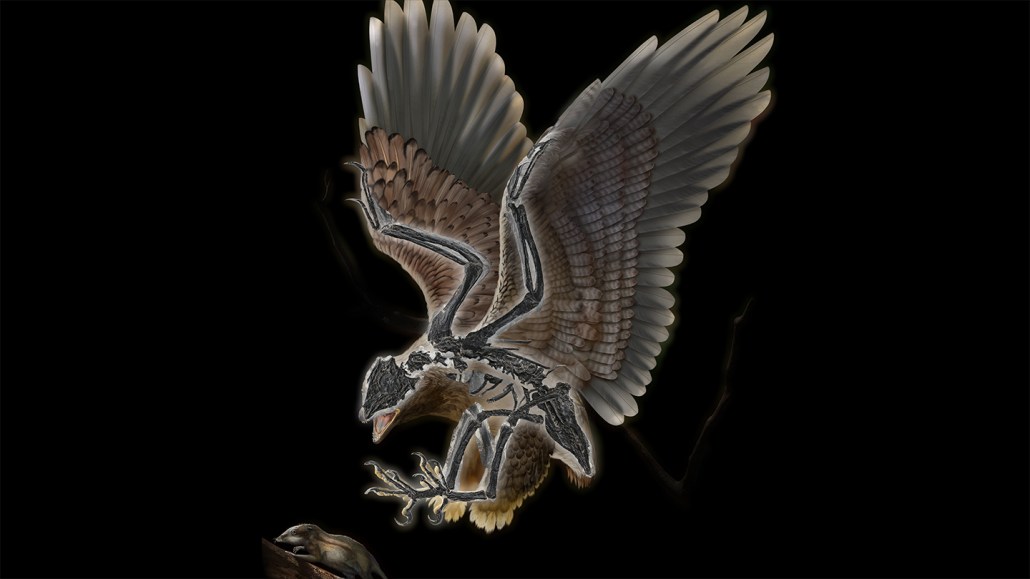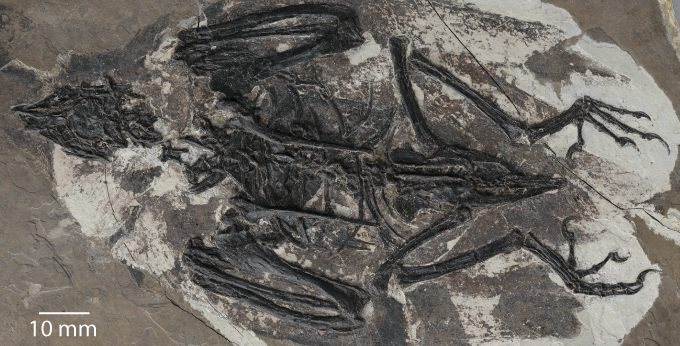This ancient bird rocked a head like a T. rex
A 120-million-year-old fossil could help reveal how dinosaurs took to the air as birds

Cratonavis (illustrated) is a newly discovered bird from 120 million years ago. It might have once hunted like today’s meat-eating birds. But it most likely hunted insects and small animals.
Zhao Chuang
Share this:
- Share via email (Opens in new window) Email
- Click to share on Facebook (Opens in new window) Facebook
- Click to share on X (Opens in new window) X
- Click to share on Pinterest (Opens in new window) Pinterest
- Click to share on Reddit (Opens in new window) Reddit
- Share to Google Classroom (Opens in new window) Google Classroom
- Click to print (Opens in new window) Print
Modern birds are known to be the descendants of meat-eating dinosaurs called theropods. But how did today’s feathered flyers evolve from prehistoric reptiles related to T. rex? A newly uncovered bird fossil from 120 million years ago offers clues.
The ancient bird, Cratonavis zhui, had a body like today’s birds but rocked a dino-like head. That finding appeared in the January 2 Nature Ecology & Evolution. The research was led by Li Zhiheng. He’s a paleontologist at the Chinese Academy of Sciences in Beijing.
Zhiheng’s team studied a flattened fossil of Cratonavis unearthed in northeastern China. The fossil came from an ancient body of rock called the Jiufotang Formation. This rock holds a trove of fossilized feathered dinosaurs and ancient birds from 120 million years ago.
At that time, ancient birds had already evolved from one group of theropods and were living alongside nonbird dinosaurs. About 60 million years later, all nonbird dinosaurs were wiped out. The ancient birds left behind eventually gave rise to today’s hummingbirds, chickens and other birds.
CT scans helped the researchers build a digital 3-D model of the Cratonavis fossil. Those scans revealed that Cratonavis had a skull nearly identical to theropod dinosaurs like T. rex. This means that birds of Cratonavis’ time hadn’t yet evolved a movable upper jaw. The movable upper jaw of today’s birds helps them preen their feathers and snatch food.

This dino-bird mishmash “is not unexpected,” says Luis Chiappe. This paleontologist studies the evolution of dinosaurs. He works at the Natural History Museum of Los Angeles in California. Most birds discovered from the Age of Dinosaurs had teeth and more dino-like heads than today’s birds, he says. But the new fossil adds to what we know about modern birds’ mysterious ancestors.
The CT scans revealed other curious features of Cratonavis, too. For instance, the creature had weirdly long shoulder blades. These big shoulder blades are rarely seen in birds from that era. They may have offered more places for flight muscles in the bird’s wings to attach. That may have been key for Cratonavis getting off the ground, since it didn’t have a well-developed breastbone. That’s where modern birds’ flight muscles attach.
Cratonavis also had a strangely long backward-facing toe. It might have used this impressive digit to hunt like today’s birds of prey. Those meat-eaters include eagles, falcons and owls. Filling those shoes may have been too big of a job for Cratonavis, though. The ancient bird was only about as big as a dove, says Chiappe. Given its size, this teeny bird would have most likely hunted insects and the occasional lizard.







